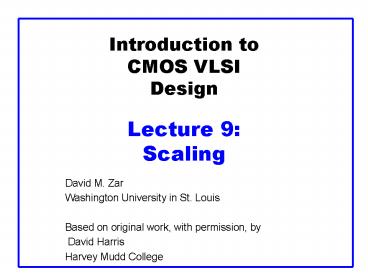Introduction to CMOS VLSI Design Lecture 9: Scaling - PowerPoint PPT Presentation
1 / 52
Title:
Introduction to CMOS VLSI Design Lecture 9: Scaling
Description:
CMOS VLSI Design. Moore's Law ... CMOS VLSI Design. Speed Improvement. Clock ... CMOS VLSI Design. Scaling. The only constant in VLSI is constant change ... – PowerPoint PPT presentation
Number of Views:696
Avg rating:3.0/5.0
Title: Introduction to CMOS VLSI Design Lecture 9: Scaling
1
Introduction toCMOS VLSIDesignLecture 9
Scaling
David M. Zar Washington University in St.
Louis Based on original work, with permission,
by David Harris Harvey Mudd College
2
Outline
- Scaling
- Transistors
- Interconnect
- Future Challenges
3
Moores Law
- In 1965, Gordon Moore predicted the exponential
growth of the number of transistors on an IC - Transistor count doubled
- every year since invention
- Predicted gt 65,000
- transistors by 1975!
- Growth limited by power
Moore65
4
More Moore
- Transistor counts have doubled every 26 months
for the past three decades.
5
Speed Improvement
- Clock frequencies have also increased
exponentially - A corollary of Moores Law
6
Why?
- Why more transistors per IC?
- Why faster computers?
7
Why?
- Why more transistors per IC?
- Smaller transistors
- Larger dice
- Why faster computers?
8
Why?
- Why more transistors per IC?
- Smaller transistors
- Larger dice
- Why faster computers?
- Smaller, faster transistors
- Better microarchitecture (more IPC)
- Fewer gate delays per cycle
9
Scaling
- The only constant in VLSI is constant change
- Feature size shrinks by 30 every 2-3 years
- Transistors become cheaper
- Transistors become faster
- Wires do not improve
- (and may get worse)
- Scale factor S
- Typically
- Technology nodes
10
Scaling Assumptions
- What changes between technology nodes?
- Constant Field Scaling
- All dimensions (x, y, z gt W, L, tox)
- Voltage (VDD)
- Doping levels
- Lateral Scaling
- Only gate length L
- Often done as a quick gate shrink (S 1.05)
11
Device Scaling
12
Device Scaling
13
Device Scaling
14
Device Scaling
15
Device Scaling
16
Device Scaling
17
Device Scaling
18
Device Scaling
19
Device Scaling
20
Device Scaling
21
Device Scaling
22
Device Scaling
23
Observations
- Gate capacitance per micron is nearly independent
of process - But ON resistance micron improves with process
- Gates get faster with scaling (good)
- Dynamic power goes down with scaling (good)
- Current density goes up with scaling (bad)
- Velocity saturation makes lateral scaling
unsustainable
24
Example
- Gate capacitance is typically about 2 fF/mm
- The FO4 inverter delay in the TT corner for a
process of feature size f (in nm) is about 0.5f
ps - Estimate the ON resistance of a unit (4/2 l)
transistor.
25
Solution
- Gate capacitance is typically about 2 fF/mm
- The FO4 inverter delay in the TT corner for a
process of feature size f (in nm) is about 0.5f
ps - Estimate the ON resistance of a unit (4/2 l)
transistor. - FO4 5 t 15 RC
- RC (0.5f) / 15 (f/30) ps/nm
- If W 2f, R 8.33 kW
- Unit resistance is roughly independent of f
26
Scaling Assumptions
- Wire thickness
- Hold constant vs. reduce in thickness
- Wire length
- Local / scaled interconnect
- Global interconnect
- Die size scaled by Dc ? 1.1
27
Interconnect Scaling
28
Interconnect Scaling
29
Interconnect Scaling
30
Interconnect Scaling
31
Interconnect Scaling
32
Interconnect Scaling
33
Interconnect Scaling
34
Interconnect Scaling
35
Interconnect Scaling
36
Interconnect Delay
37
Interconnect Delay
38
Interconnect Delay
39
Interconnect Delay
40
Interconnect Delay
41
Interconnect Delay
42
Interconnect Delay
43
Observations
- Capacitance per micron is remaining constant
- About 0.2 fF/mm
- Roughly 1/10 of gate capacitance
- Local wires are getting faster
- Not quite tracking transistor improvement
- But not a major problem
- Global wires are getting slower
- No longer possible to cross chip in one cycle
44
ITRS
- Semiconductor Industry Association forecast
- Intl. Technology Roadmap for Semiconductors
45
Scaling Implications
- Improved Performance
- Improved Cost
- Interconnect Woes
- Power Woes
- Productivity Challenges
- Physical Limits
46
Cost Improvement
- In 2003, 0.01 bought you 100,000 transistors
- Moores Law is still going strong
Moore03
47
Interconnect Woes
- SIA made a gloomy forecast in 1997
- Delay would reach minimum at 250 180 nm, then
get worse because of wires - But
SIA97
48
Interconnect Woes
- SIA made a gloomy forecast in 1997
- Delay would reach minimum at 250 180 nm, then
get worse because of wires - But
- Misleading scale
- Global wires
- 100 kgate blocks ok
49
Reachable Radius
- We cant send a signal across a large fast chip
in one cycle anymore - But the microarchitect can plan around this
- Just as off-chip memory latencies were tolerated
50
Dynamic Power
- Intel VP Patrick Gelsinger (ISSCC 2001)
- If scaling continues at present pace, by 2005,
high speed processors would have power density of
nuclear reactor, by 2010, a rocket nozzle, and by
2015, surface of sun. - Business as usual will not work in the future.
- Intel stock dropped 8
- on the next day
- But attention to power is
- increasing
Moore03
51
Static Power
- VDD decreases
- Save dynamic power
- Protect thin gate oxides and short channels
- No point in high value because of velocity sat.
- Vt must decrease to
- maintain device performance
- But this causes exponential
- increase in OFF leakage
- Major future challenge
Dynamic
Static
Moore03
52
Productivity
- Transistor count is increasing faster than
designer productivity (gates / week) - Bigger design teams
- Up to 500 for a high-end microprocessor
- More expensive design cost
- Pressure to raise productivity
- Rely on synthesis, IP blocks
- Need for good engineering managers































